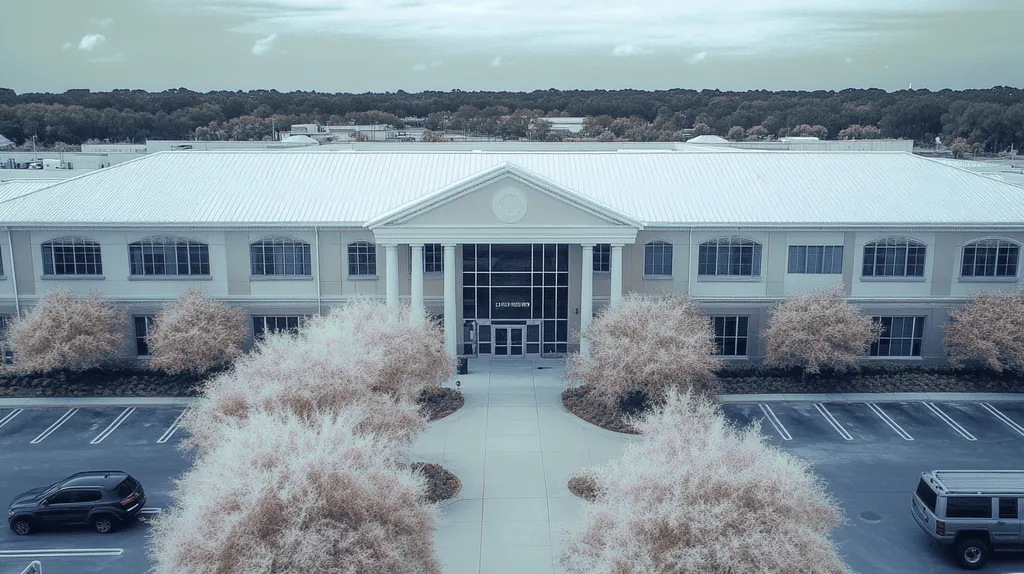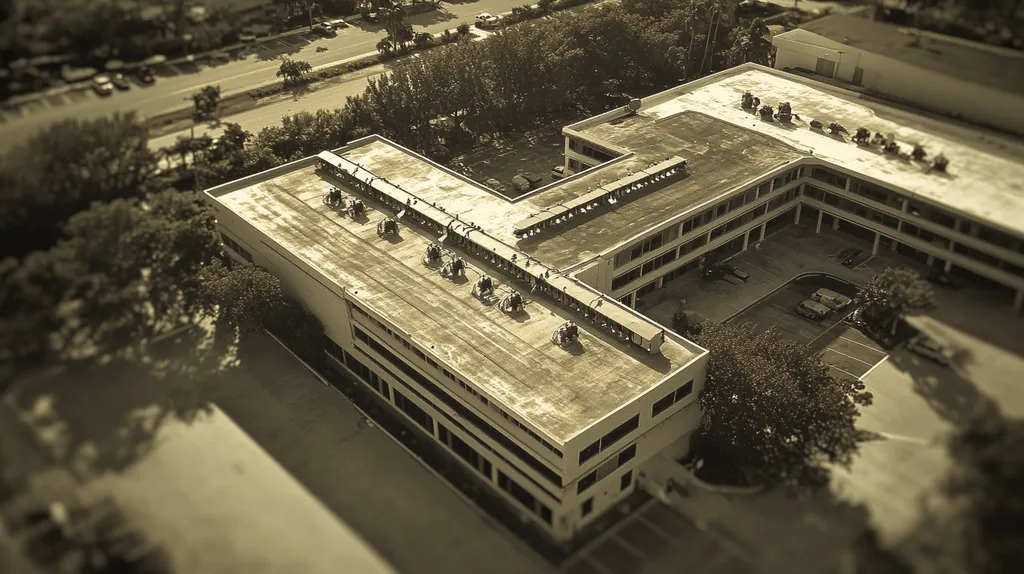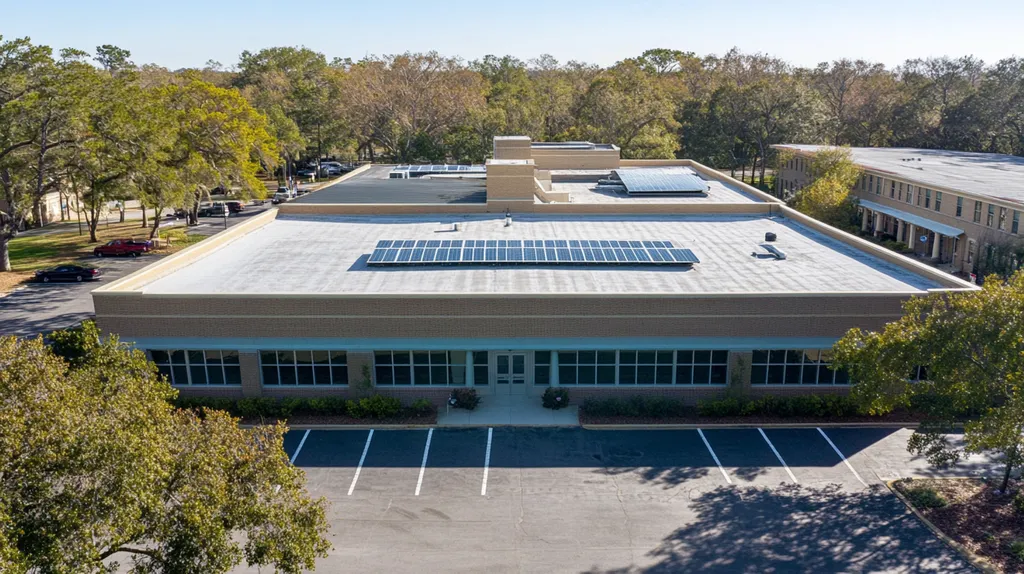Undetected moisture intrusion costs industrial facilities billions annually in structural damage, with studies showing that over 40% of commercial roof failures stem from inadequate moisture detection practices.
As roofing systems become increasingly complex, utilizing the right moisture scanning tools has become critical for protecting these valuable assets and preventing catastrophic failures.
This comprehensive guide examines the essential tools and technologies that enable facility managers to identify moisture issues early, from advanced infrared systems to nuclear moisture gauges, helping organizations safeguard their roofing investments and maintain structural integrity.
SECTION 1: FUNDAMENTAL CONCEPTS
Moisture intrusion in industrial roofing systems can lead to devastating consequences, including structural damage and increased energy costs. Alarmingly, research indicates that nearly 80% of roof failures are linked to moisture-related issues. To shield investments and minimize operational disruptions, property owners and facility managers must prioritize effective moisture detection and management. This section explores the core principles of moisture detection, investigates how different roofing materials react to moisture, and outlines essential industry standards for moisture scanning.
Principles of Moisture Detection
Successful moisture detection hinges on an understanding of water’s behavior in roofing systems. Identifying moisture early can thwart significant damage and keep costs manageable. The industry employs various tools, including infrared thermography and electrical capacitance, to ensure accurate assessments.
Infrared thermography detects moisture by analyzing heat signatures beneath the roof membrane, offering a powerful non-invasive option. Meanwhile, electrical capacitance gauges the dielectric constant of materials, allowing for rapid and precise moisture level assessments. Both techniques have distinct advantages and limitations, making it crucial to select the right tool for any given situation.
Combining different methods can also boost detection accuracy. For instance, pairing infrared scans with contact moisture meters can help locate leaks more precisely. Grasping these principles is essential for anyone aiming to effectively manage moisture in roofing systems.
Neglecting proper detection can allow even small leaks to escalate into major problems, jeopardizing structural integrity and indoor air quality. Regular moisture assessments are vital for maintaining functional and efficient roofing systems.
Types of Roofing Materials and Moisture Behavior
Roofing materials exhibit varying moisture behaviors, making it important to understand their individual characteristics. Common materials like TPO, EPDM, PVC, and modified bitumen differ in their susceptibility to moisture. For instance, TPO and PVC membranes typically provide strong moisture resistance, while modified bitumen might retain water if not installed correctly.
Additionally, the way materials are layered during installation significantly influences moisture retention. Seams that are improperly sealed or punctured can lead to substantial moisture accumulation. By familiarizing themselves with each material’s properties, property owners can tailor their moisture detection strategies for optimal effectiveness.
The climate and location of a facility also play a crucial role in moisture behaviors. Roofs in humid areas are more prone to condensation problems than those in drier climates. Adapting moisture scanning techniques to these specific conditions enhances the likelihood of successful outcomes.
Ignoring these factors can result in unanticipated moisture issues that jeopardize the roofing system’s integrity. A proactive understanding of material properties and environmental impacts is key to effective moisture management.
Industry Standards for Moisture Scanning
Adhering to industry standards is critical for conducting effective moisture scanning. Organizations such as ASTM International establish guidelines that enable roofing professionals to carry out moisture assessments accurately and consistently. Compliance with these standards fosters reliability in detection practices.
For example, ASTM D7954 provides best practices for using infrared thermography in moisture detection, detailing optimal temperature differentials and scanning techniques. Establishing quality control during scanning processes is essential for achieving accurate results.
Moreover, familiarity with industry standards empowers facility managers to evaluate their moisture detection practices against these benchmarks, ensuring they do not overlook vital detection needs.
Ongoing training on these standards is crucial for the workforce in roofing. Continuous education keeps professionals up to date on advancements in moisture detection methods and technologies, enabling proactive measures to mitigate potential risks.
SECTION 2: SYSTEM COMPONENTS
Moisture intrusion poses a serious threat to industrial roofs, resulting in expensive repairs and unplanned downtime. The National Roofing Contractors Association notes that water damage can cause structural failures, potentially shortening a roof’s lifespan by up to 50%. Investing in advanced moisture scanning tools can distinguish between protecting your roofing investment and incurring unexpected repair costs. This section highlights essential tools available for pinpointing moisture-related issues in industrial roofing systems.
Electrical Impedance Scanners
Electrical impedance scanners have become indispensable in moisture detection for industrial roofs. These devices measure the resistance of roofing materials to electrical currents, allowing them to reveal hidden moisture without invasive procedures. By sending a small electrical current through roofing materials, these tools provide real-time insights into moisture levels.
The primary advantage of electrical impedance scanners is their immediacy. Property managers can quickly locate wet areas without destructive testing, leading to targeted repairs that save time and money. This swift identification allows teams to address problems before they escalate.
Moreover, the versatility of these scanners enables their application across diverse roofing materials, making them ideal for various facilities. Their rapid testing capabilities ensure that moisture issues are flagged promptly, safeguarding the structural integrity of the roof.
By effectively pinpointing areas needing attention, these scanners also enhance resource allocation during maintenance. This precision allows facility managers to optimize repair budgets and prioritize critical areas.
Infrared Thermal Imaging Cameras
Infrared thermal imaging cameras provide a powerful, non-invasive solution for detecting moisture on industrial roofs. These devices visualize temperature differences across the roof surface, pinpointing areas where moisture is trapped underneath. Typically, moisture will correlate with temperature variations that these cameras can detect almost instantly.
The efficiency of thermal imaging significantly reduces the time required for inspections. Instead of meticulously checking every inch of a roof, inspectors can quickly evaluate large areas and identify problem spots from a distance.
This technology not only aids in immediate inspections but also supports proactive maintenance planning. By continuously assessing roof conditions, property managers can schedule necessary repairs prior to leaks converting into larger liabilities. This foresight extends the life of roofing systems and preserves building integrity.
Additionally, the data collected from thermal imaging can bolster reporting and documentation efforts. Having precise documentation on hand can justify maintenance investments and set a reliable baseline for future inspections, leading to more informed decision-making as conditions evolve.
Nuclear Moisture Gauges
Nuclear moisture gauges are considered an industry-standard tool for detecting moisture beneath the roof surface, especially in larger industrial applications. These devices utilize radioactive isotopes to measure moisture levels. By emitting radiation and analyzing the resulting emissions, they deliver highly accurate readings crucial for effective roof management.
The precision of nuclear moisture gauges facilitates detailed assessments. This specificity is vital in preventing water damage, especially in settings with strict safety protocols in place. Their accuracy can be invaluable in maintaining compliance with industry standards.
However, using nuclear technology entails regulatory requirements. Facilities must ensure proper training and adherence to safety guidelines when operating these devices. Despite their complexities, the long-term benefits, including reliable data and durability, often justify the costs and regulations associated with their usage.
Nuclear moisture gauges can also complement other scanning methods, offering a comprehensive perspective on a roofing system’s moisture conditions. This multi-faceted approach enhances strategic decision-making, ultimately leading to significantly reduced overall costs.
SECTION 3: IMPLEMENTATION METHODS
Moisture scanning on industrial roofs is essential for safeguarding structural integrity and prolonging roof life. Without effective moisture management, businesses can face costly damages, wasteful energy use, and significant safety hazards. Alarmingly, industry studies reveal that over 30% of roof failures arise from undetected moisture issues. This section delves into effective methodologies for implementing moisture scanning, with a focus on non-destructive testing techniques, calibration and sensitivity adjustments, and expert data interpretation.
Non-Destructive Testing Techniques
Non-destructive testing (NDT) plays a vital role in assessing moisture levels without harming the roof structure. Tools such as infrared cameras and nuclear moisture sensors provide immediate insights into hidden moisture problems. Infrared technology detects temperature variations that signal the presence of moisture trapped beneath the roof surface.
Electrical capacitance meters are another effective method, measuring the dielectric properties of roofing materials to accurately identify moisture content. Both techniques can be utilized concurrently, enhancing the overall assessment of the roofing system.
The primary advantage of NDT is its capacity to uncover issues before they develop into expensive repairs. Property owners gain critical insights into their roofs’ vulnerabilities while avoiding invasive procedures.
When selecting NDT tools, professionals should consider the specific roofing membranes and environmental conditions impacting performance. This understanding allows for tailored scanning strategies that maximize the efficiency of moisture assessments.
Calibration and Sensitivity Adjustment
Accurate moisture readings rely heavily on proper calibration and sensitivity settings of testing equipment. Regular calibration ensures that tools yield reliable results, regardless of varying environmental conditions. Factors like temperature and humidity can influence readings, necessitating adjustments for accuracy.
Facility managers should implement a routine calibration schedule, ideally before each scanning session. This proactive approach helps safeguard data integrity. Additionally, adjusting sensitivity settings based on the material being tested is essential to minimize the risk of false readings.
Well-calibrated tools not only provide accurate insights but also result in time and resource optimization. By avoiding unnecessary retests due to faulty data, property owners can streamline their maintenance strategies.
Involving trained professionals in the calibration process can significantly enhance accuracy. Experts possess the knowledge to make adjustments in line with specific roofing conditions and moisture-related challenges.
Data Interpretation and Mapping
After completing the moisture scanning, the next step is to interpret the collected data. Professionals must analyze the results to identify areas of concern while creating a moisture map. This visual representation outlines moisture levels across different roof sections, facilitating informed decision-making.
Contextual understanding of the data is crucial. A high moisture reading in a specific area might indicate a localized leak, while widespread moisture could reveal systemic issues, such as inadequate drainage. Pinpointing the moisture source is essential for implementing effective long-lasting solutions.
Data interpretation also involves reviewing historical data and trends. Facility managers should compare current readings with prior moisture scans to assess the effectiveness of previous repairs and maintenance efforts.
By generating an actionable plan based on the moisture map, property owners can prioritize repairs, allocate budgets effectively, and ultimately extend the lifespan of their roofing systems. Accurate data leads to informed decisions that protect both the asset and the investment.
SECTION 4: MAINTENANCE REQUIREMENTS
Maintaining moisture scanning tools is vital for the long-term performance and integrity of industrial roofs. Research shows that improper maintenance can significantly skew moisture readings, potentially leading to hefty repair bills or premature roof replacements. Proactive upkeep will not only extend the lifespan of scanning equipment but also guarantee reliable data collection over time. This section highlights critical aspects of maintenance, including regular calibration, troubleshooting common problems, and best practices for storing and handling tools.
Regular Calibration and Maintenance
Ensuring the accuracy of moisture scanning tools starts with regular calibration. When tools are not calibrated correctly, the results can be misleading, undermining the evaluation of the roof’s condition. Ideally, calibration should coincide with significant usage, aligning with the manufacturer’s guidelines to ensure consistent performance.
Beyond calibration, routine cleaning and inspection are essential for optimal tool functionality. Accumulated dirt or moisture on sensors can interfere with readings, so checking these components regularly is crucial. Keeping sensors and lenses clear of obstructions enhances the reliability of the data collected.
Maintaining a detailed log that tracks calibration dates and repairs is also beneficial. This historical record serves as a crucial resource for monitoring equipment performance and enforcing proactive maintenance schedules.
By establishing and adhering to a stringent maintenance regimen, individuals can feel confident in the accuracy of their moisture assessments, thereby protecting their investment in roofing materials and labor.
Troubleshooting Common Issues
Proactively addressing common issues with moisture scanning tools can prevent costly delays and inaccuracies. One common problem arises from poor calibration, which should be remedied immediately. If readings appear inconsistent, recalibrating the tool in a controlled environment is the first course of action.
Additionally, environmental factors, such as temperature fluctuations, can introduce anomalies in readings. Operators must recognize how ambient conditions can impact tool performance and adjust operational strategies accordingly.
Software glitches, particularly in digital scanning models, can complicate assessments. Regular updates are vital, as manufacturers provide patches that improve functionality. Keeping software current will help minimize unforeseen problems.
Familiarizing staff with common error messages that arise during operation also aids troubleshooting. Understanding these cues can lead to quick diagnoses and resolutions, minimizing downtime and keeping operations on track.
Storage and Handling Best Practices
Proper storage and handling of moisture scanning tools are crucial for extending their lifespan and ensuring ongoing accuracy. Tools should be kept in a dry, climate-controlled environment to shield them from extreme humidity and temperature changes, which can result in malfunctions or permanent damage.
Using high-quality protective cases when transporting tools helps safeguard them from physical damage. Operators should avoid placing heavy items on top of tools, as this can misalign components and affect measurement accuracy.
Allowing tools to acclimate to external temperatures before use can also prevent performance issues. Abrupt temperature changes can lead to condensation, which may interfere with readings.
Training staff in proper handling techniques ensures that tools are utilized correctly, reducing the risk of user-induced damage and maintaining their effectiveness for accurate moisture scanning.
SECTION 5: PERFORMANCE METRICS
Understanding the performance metrics of moisture scanning tools is crucial for effective industrial roof maintenance. Moisture-related issues can lead to costly repairs and significant operational disruptions. Alarmingly, the National Roofing Contractors Association identifies roof leaks as a leading cause of asset damage in commercial properties. Evaluating metrics such as accuracy, reliability, and comparative effectiveness empowers property owners to make informed decisions that safeguard their investments. This section will explore these essential performance metrics.
Accuracy and Reliability Metrics
Accuracy is vital in moisture scanning. For tools to be effective, they must deliver reliable readings that prevent misdiagnosis of roofing issues. High-quality moisture meters often achieve an accuracy rate of 90% or higher, enabling property owners to trust their data. Regular calibration and maintenance of these devices significantly enhance reliability.
Property managers should prioritize tools with established performance records and positive user feedback. Advanced models often come equipped with features like automatic calibration and real-time data transmission, further ensuring dependable results. This reliability minimizes the risk of unexpected complications on site.
For example, while infrared thermography is a widely-used technique, it can yield misleading results if not used properly. Investing in tools that include robust quality assurance mechanisms is essential for maintaining the integrity of moisture assessments.
Ultimately, utilizing accurate and reliable moisture scanning tools leads to more effective maintenance strategies and cost savings, providing vital protection against moisture-related damage.
Depth Penetration and Sensitivity
The ability of moisture scanning tools to penetrate depth is a key factor in detecting moisture beneath the roof’s surface. Tools with greater depth capabilities can identify moisture trapped within insulation materials, where significant problems often originate. Recognizing each tool’s depth penetration capacity is crucial for addressing potential issues proactively.
Some devices, like nuclear density gauges, have the ability to penetrate deeper than standard resistance meters. However, they come with regulatory requirements and necessitate specialized training, making depth penetration a critical consideration for choosing the right tool based on the roofing structure.
Sensitivity, too, is essential in moisture detection. Tools capable of detecting minute variations in moisture levels offer vital insights for preventive maintenance. High-sensitivity meters can identify moisture variations as low as 0.1%, a critical capability in early-stage assessments.
In conclusion, both depth penetration and sensitivity significantly impact a tool’s effectiveness, making it imperative for facility managers to consider these metrics when investing in moisture scanning technology.
Comparison of Detection Methods
Each moisture detection method has its own unique strengths and weaknesses. For example, infrared thermography excels at rapidly visualizing moisture patterns but may falter when assessing insulation materials that impede thermal signatures. On the other hand, dielectric moisture meters are effective for measuring moisture content but necessitate direct contact with surfaces.
Acoustic methods can provide valuable insights into roofing conditions, although they may yield vague results in complex roof assemblies. A thorough understanding of these methods allows property managers to customize their approaches according to the specifications of their roofing systems.
Cost considerations also vary between methodologies, impacting property owners’ budgets. While advanced tools may carry higher upfront costs, their ability to prevent larger issues from arising can lead to long-term savings, highlighting the importance of careful method selection.
By comparing these moisture detection methods, property owners can determine which solutions are most suited to their specific scenarios. Striking a balance between effectiveness, cost, and applicability is vital for ensuring the long-term health of roofing systems.
SECTION 5: PERFORMANCE METRICS
Understanding the performance metrics of moisture scanning tools is critical for effective industrial roof maintenance. Moisture-related issues can lead to costly repairs and serious operational disruptions. According to the National Roofing Contractors Association, roof leaks are among the top culprits of asset damage in commercial properties. By evaluating key metrics like accuracy, reliability, and method comparisons, property owners can safeguard their investments and avoid common pitfalls. This section will examine these essential performance metrics.
Accuracy and Reliability Metrics
Accuracy is crucial in moisture scanning. Tools need to deliver reliable readings to prevent misdiagnosing roofing issues. High-quality moisture meters typically achieve an accuracy rate of 90% or higher, instilling confidence in property owners about their data. Consistent calibration and maintenance of these devices greatly enhance their reliability.
Property managers should focus on tools with proven track records and positive user reviews. Advanced models often include features such as automatic calibration and real-time data transmission, ensuring dependable results. This reliability significantly reduces the chance of unexpected complications during assessments.
For example, infrared thermography is a popular method that can provide misleading results if not applied correctly. Therefore, it is essential to pursue tools with robust quality assurance mechanisms to maintain the integrity of moisture assessments.
Ultimately, utilizing accurate and reliable moisture scanning tools translates to more effective maintenance strategies and cost savings, protecting buildings from potential moisture-related damage.
Depth Penetration and Sensitivity
The depth penetration of moisture scanning tools is vital for effectively detecting moisture beneath the roof surface. Tools with greater depth capabilities can uncover moisture trapped within insulation materials, where serious problems often begin. Understanding the penetration depth of each tool is key to addressing potential issues proactively.
For instance, nuclear density gauges can penetrate deeper than standard resistance meters but require compliance with regulatory guidelines, necessitating specialized training. Thus, depth penetration becomes a significant factor when selecting the right tool based on the specific roofing construction.
Sensitivity also plays a pivotal role in moisture detection. Tools capable of detecting minute variations in moisture levels offer valuable insights for preventive maintenance. High-sensitivity meters can identify moisture changes as small as 0.1%, essential for early-stage assessments.
In conclusion, both depth penetration and sensitivity significantly impact a tool’s overall effectiveness, making it essential for facility managers to consider these metrics when investing in moisture scanning technology.
Comparison of Detection Methods
Each moisture detection method has distinct strengths and weaknesses. For instance, infrared thermography excel at quickly visualizing moisture patterns but may struggle with insulation materials that hinder thermal signatures. On the other hand, dielectric moisture meters are efficient for measuring moisture content but require direct contact with surfaces.
Acoustic methods can also provide valuable insights into roofing conditions, though they may yield imprecise results in complex roof assemblies. Understanding these methods allows property managers to tailor their detection approach according to the unique specifications of their roofing systems.
The costs associated with each detection method may vary, influencing budget considerations for property owners. While advanced tools may carry higher initial expenses, their ability to prevent larger issues can lead to significant long-term savings, emphasizing the importance of method selection.
By comparing these moisture detection methodologies, property owners can identify the most suitable solutions for their specific needs. Striking a balance between effectiveness, cost, and feasibility is crucial for ensuring the long-term health of roofing systems.
The Bottom Line
With over $3.3 billion lost annually to moisture-related roof damage in industrial facilities, implementing effective moisture scanning protocols is no longer optional—it’s imperative for business survival.
The integration of advanced tools like infrared cameras, nuclear moisture gauges, and electrical impedance scanners provides facility managers with unprecedented capabilities to detect and prevent catastrophic moisture issues.
Organizations that embrace these technologies, while following proper maintenance protocols and industry standards, can extend their roof’s lifespan by up to 50% and reduce emergency repairs by 70%.
As roofing systems continue to evolve in complexity, the strategic deployment of moisture scanning tools will become increasingly critical for protecting these vital assets and ensuring operational continuity.
FREQUENTLY ASKED QUESTIONS
Q. What causes moisture issues in commercial roofs?
A. Moisture issues in commercial roofs can arise from improper installation, aging materials, and environmental conditions. Water infiltration through seams or punctures can lead to significant damage if not detected early. Understanding these causes helps in implementing effective moisture detection strategies to protect assets.
Q. What tools are best for assessing an industrial roof’s moisture?
A. Tools like electrical impedance scanners and infrared thermal imaging cameras are highly effective for moisture assessment. They provide non-invasive methods to pinpoint moisture locations quickly. Utilizing multiple tools can enhance accuracy and help identify potential leaks before they escalate.
Q. How do I implement moisture scanning on industrial roofs?
A. Implementing moisture scanning involves using non-destructive testing methods and correctly calibrating tools. Regular assessments should be scheduled to monitor changes over time. Analyzing results and creating moisture maps help in making informed decisions for repairs and maintenance.
Q. How often should I calibrate moisture scanning equipment?
A. Regular calibration should occur before each major scanning session or as recommended by the manufacturer. Humidity and temperature can affect measurements, so frequent checks ensure consistent performance. Keeping a maintenance log aids in tracking calibration schedules.
Q. What are key performance metrics for moisture scanning tools?
A. Key performance metrics include accuracy, reliability, depth penetration, and sensitivity. High-quality tools should provide reliable readings consistently and effectively identify moisture depth. Comparing various methods ensures the best fit for specific facilities and their moisture inspection needs.
Q. How should I store moisture scanning tools?
A. Store moisture scanning tools in a dry, climate-controlled environment to protect them from damage. Using protective cases prevents physical harm during transport. Training staff on proper handling techniques further ensures longevity and functionality for accurate assessments.
Q. What are the benefits of proactive moisture scanning?
A. Proactive moisture scanning helps identify potential leaks early, preventing costly repairs and structural damage. Regular assessments maintain roof integrity, optimize energy efficiency, and extend overall lifespan. This proactive approach safeguards investments and promotes a sustainable environment for tenants and communities.










